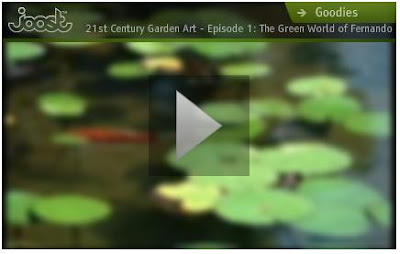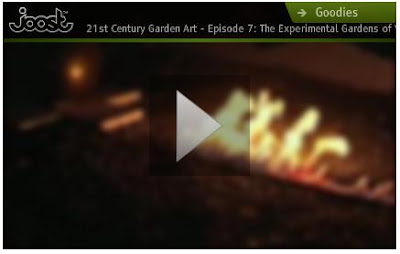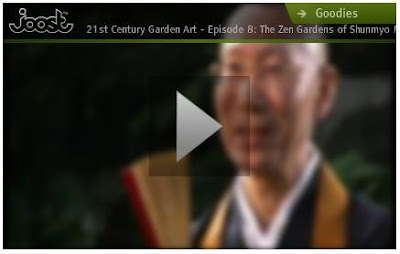
21st Century Garden Art” presents the latest innovations, as well as the most
interesting persons setting the pace for landscape and garden architecture. We
portray garden artists who, by respecting national traditions as well as the unique
nature and character of the local topography, have succeeded in establishing a living
relationship between their gardens and the realities of modern culture.
Although each of these leading designers has been steeped in the history, culture
and gardening traditions of the diverse lands in which they were born, their work
reflects an understanding that today’s garden and landscape artists must address
fundamentally new challenges. Indeed, they must justify their very existence; for, in a
world where arable land is an increasingly scarce resource, the gardener’s art can
too easily be relegated to a secondary consideration, one worthy to be addressed
only after structural design has been established. Moreover, within a societal context,
the gardener’s task may be limited to the mere re-greening of derelict industrial sites;
or restricted simply to the luxury market, its limited purview the design of valuable,
privately held property.
In the light of these challenges: What forms can gardens be expected to take in the
21st century? And, which functions must a present day garden fulfill? In sum, the
age-old dilemma: How can human culture be reconciled to the natural environment?
And, can modern mankind regain its lost Paradise?
The unique personalities and the varying strategies of the diverse artists portrayed,
and, even more so, the gardens themselves demonstrate the remarkable variety of
“21st Century Garden Art.” And nevertheless, despite this fascinating variety of
styles, personalities and professional backgrounds, the objectives of the artists
portrayed in this series are held in common: To create gardens which can serve as
retreats, Paradises for the modern age - in sum, gardens filled with memories of the
past, but designed for the future.
Guia dos Episodios:
The Green World of Fernando Caruncho
Gardens and Squares of WEST 8
The Eden Project of Tim Smit
The Mobile Gardens of Atelier Alias
The Healing Gardens of Topher Delaney
The Private Jungles of Patrick Blanc
The Experimental Gardens of Vladimir Sitta
The Zen Gardens of Shunmyo Masuno
The Tropical Paradise of Made Wijaya
The Enchanted Gardens of Ivan Hicks
Charles Jencks Garden of Cosmic Speculation
The Water Gardens of Anthony Paul
The Gardens of Breimann & Brunn
OS EPISÓDIOS
 The Green World of Fernando Caruncho (Episode 1)
The Green World of Fernando Caruncho (Episode 1)
Fernando Caruncho’s body of work is firmly rooted in the philosophies of antiquity,
calling to an observer’s mind Spain’s Moorish history. And though his gardens create
visually poetic landscapes, they clearly portray their contemporary context. The
stunningly beautiful and austere Iberian Peninsula sets the tone and emotional basis
for Caruncho’s poetic work, whose play of light and shade, often across reflective
pools, is magical in effect.
http://www.fernandocaruncho.com/intro.html
 Gardens and Squares of WEST 8 (Episode 2)
Gardens and Squares of WEST 8 (Episode 2)
Adriaan Geuze and his team “West 8”, working in Europe’s most densely populated
country, seek in their urban landscape planning to reconcile modern, mass culture to
the Netherlands’ natural environment. And, despite the daunting scope of this task,
they approach their planning work with a charming trace of irony and humor. Named
for the force 8 winds that blow into Rotterdam off the North Sea, the Dutch team is
thoroughly modern, both in terms of how it views its mission, and in the industrial
materials it favors in its creations.
Geuze’s thought provoking commentary, flavored with remarkably positive
expectations for the future of gardening, is strictly “cutting edge,” and visits to the
team’s principal projects is, frankly stated, eye opening!

The Eden Project of Tim Smit (Episode 3)
England’s Tim Smit is not an advocate for contemporary gardening, having, in fact,
become a garden designer more by accident than design. That occurred when he
discovered the “Lost Gardens of Heligan” – a Victorian estate which, like Sleeping
Beauty’s Castle, had slumbered forgotten in Cornwall for more than 60 years.
With a surfeit of conviction, hard work and human energy, Smit and his workforce
managed to resurrect the Estate’s enormous original gardens, including the
ornamental and kitchen gardens – restoring all to pristine condition. These historic
gardens were then supplemented by a remarkable, wholly modern counterpart: “The
Eden Project,” the world’s largest greenhouse.
Designed by renowned architect Nicolas Grimshaw, the Project - featuring displays of
flora from multifarious climactic zones, - has become enormously popular, drawing
visitors from throughout the world. From the Heligan Project to the Eden Project, the
film traces the transition of Smits from a restorer of historic garden art to becoming
one of the world’s leading innovators in garden and climactic design.
 The Mobile Gardens of Atelier Alias (Episode 4)
The Mobile Gardens of Atelier Alias (Episode 4)
The Leipzig, Germany based team Atelier Alias is dedicated to gardening in its
largest communal and municipal senses. Comprised of Bertram Weisshaar, Katja
Heinecke and Reinhard Krehl, each a graduate in landscape design, Atelier Alias is
dedicated to exploring new means of perceiving landscapes and municipal land use.
Their actions, such as “Gardens on Wheels,” “Shipwrecked Gardens” and the Garden
Exchange cooperative portrayed in the film, have established their bona fides as
leading edge innovators in 21st Century governmental gardening policy. Interestingly,
their engagement in municipal garden policy in no way offsets the intimacy of their
own fragile, small garden creations.
Indeed, as the film lovingly shows, a small experimental garden may have a life of but
a few moments. Say its creators: “If the experiment succeeds, in a very few minutes
the three will create a moment filled with poetry. It is beauty, but only for the
moment.”
 The Healing Gardens of Topher Delaney (Episode 5)
The Healing Gardens of Topher Delaney (Episode 5)
Topher Delaney of San Francisco exploits the excellent conditions of California’s
climate to create highly individualized private gardens. In designing her spiritual
gardens, Delaney draws upon her experiences with Zen Buddhism, pursuing an
integrative process far exceeding the demands of classic horticulture. Moreover,
inspired by her own successful battle with cancer, Delaney’s gardens are conceived
as places of retreat and healing.
The film’s setting is glorious, presenting Delaney at work and in interviews throughout
the breathtakingly beautiful San Francisco Bay Area
http://www.tdelaney.com/
http://archrecord.construction.com/people/profiles/archives/0201profile.asp
 The Private Jungles of Patrick Blanc (Episode 6)
The Private Jungles of Patrick Blanc (Episode 6)Patrick Blanc was an internationally celebrated tropical botanist long before his “plant
walls” came on the scene. Faced with an increasingly ugly, green free, cement
jungle, Blanc’s research led him to discover that plants could survive and even thrive
in the absence of soil.
His development of vertical gardens and the technology that enables their creation
has engendered a true revolution in traditional gardening. His vertical plant beds find
their sustenance in the felt covering of the wall’s construction. By carefully arranging
diversely colored plants on the wall “palette,” the French artist can create a rich
variety of images. The resulting floral tapestries are reminiscent of the jungle themes
in the artwork of the French master, Henri Rousseau. Binding the work of these two
artists across the centuries is their common love for the boundless richness of the
jungle. Patrick Blanc’s passion is not for traditional gardens; his heart belongs to the
jungle.
http://www.verticalgardenpatrickblanc.com/
 The Experimental Gardens of Vladimir Sitta (Episode 7)
The Experimental Gardens of Vladimir Sitta (Episode 7)
Vladimir Sitta arrived in Australia only twenty years ago. Since then, the Czech native
has proven himself a ground breaking innovator in contemporary landscape
architecture - not only in the creation of gardens for his adopted home of Sydney, but
in widely ranging projects throughout the “Fifth Continent.”
Vladimir Sitta treats gardens as theatrical stages, to be variously set and dressed in
order to convey the broadest range of dramatic narratives. His leading actors are thefour elements: Fire, Water, Earth and Air. And, with a theater manager’s eye for
detail, Sitta calls upon the latest “special effects” technologies to achieve his stage
picture – being willing even to cast open flames upon his garden-stage.
Due to a perfectionist nature, as well as the use of only the finest building materials,
Sitta manages to turn tiny, city gardens into exquisite examples of modern gardening
art. He says: Probably all gardens are romantic, because we believe that they will
somehow survive us. I wouldn’t describe myself as a complete Romantic. But I am
perhaps Romantic insofar as I believe that my gardens can make a positive impact
for change.”
http://terragram.com.au/Work/
http://www.land8lounge.com/profile/VladimirSitta

The Zen Gardens of Shunmyo Masuno (Episode 8)
The ancient traditions and magnificent art of Japanese garden design continue to
exercise an enormous, international influence on contemporary garden architecture.
21st Century Garden Art is proud to present a filmed portrait of Shunmyo Masuno,
the internationally recognized master of Japanese garden style.
The 50-year old professor of garden design lives in Yokohama, Japan’s second
largest city. Masuno is an 18th generation Zen priest, and the very last of his order
still engaged in garden creation. Masuno’s gardens reflect the combined inspiration
of Japanese and Buddhist traditions. Significantly, the Zen monk has not withdrawn
from the modern world. On the contrary, his designs can be found today in the great,
modern cities of Tokyo and Yokohama - for whose stressed inhabitants the artist has
endeavored to create oases of quiet and serenity.
Masuno considers it his responsibility to create gardens, composed of stones and
metaphors, which invite their visitors to adopt a simpler, more serene worldview. To
accomplish this task he places particular significance on a dialogue with the particular
garden’s elements, as to where they ought to be placed: “I think that the most
important thing in executing a design is to talk to the plants and stones and hear what
they themselves have to say about how they wish to be laid out.”
Aided by extraordinary camera work and a sensitively attuned musical score, the film
presents Masuno’s own monastery garden, as well as four of the Master’s
contemporary projects.
http://www.kenkohji.jp/s/english/index_e.html
The Tropical Paradise of Made Wijaya (Episode 9)
Living and working on the Island of Bali, Made Wijaya is considered THE leading
contemporary exponent of exotic garden design. To date, the fifty year old gardener
has created more than seven hundred tropical gardens.
Through his designs Made Wijaya attempts to subjugate the jungle to his control. It is
not uncommon to find many hundreds of differing plant species combined in a single
Wijaya installation. Given the artist’s awesome creativity, the climactic advantages of
the tropics, and the unrestricted budgets of his clients, Wijaya has been free to
recreate the Garden of Eden.
21st Century Garden Art presents many of Wijaya’s most impressive Balinese
gardens. The island itself serves as his Muse; so, regardless where in the world a
Wijaya garden is created, one encounters his classic Balinese style
 The Enchanted Gardens of Ivan Hicks (Episode 10)
The Enchanted Gardens of Ivan Hicks (Episode 10)
Ivan Hicks is very likely England’s drollest garden artist. For, in a whimsical design
style of a decidedly surrealistic bent, Hicks’ art succeeds in deftly combining respect
for mythic tradition to a profoundly modern worldview.
Hicks’ garden designs are rooted in the Earth itself, baring the influence of ancient
Celtic mythology, and in particular, its worship of trees. At the same time, the
Surrealist Movement of the 20th century has had very nearly as strong an impact on
the 59-year-old artist’s work. During the 1970’s Ivan Hicks had the opportunity to
befriend a number of surrealism’s leading exponents.
21st Century Garden Art is delighted to present the most remarkable and
representative sampling of Ivan Hicks’ garden creations. From the film’s first
moments, the spectator is invited into the mysterious, magical forest of Groombridge
Place. The Mystic Pond of the garden is dedicated to the tree mythology of the Celts.
Above the black waters spiral rings of willow, while mirrored hangings glint and glitter.
Jutting up out of the water one sees animal skulls and gnarled root shaftsDuring a filmed interview, Hicks explains how the Enchanted Forest is based in the
same traditions as the Harry Potter stories and the J.R.R. Tolkien RING trilogy: “…
they are all coming from the same source in a way. We’ve all read the same books. ..
We all want to get back to back to the woods and have fun, and have magic. And
that’s what Harry Potter and the Lord of the Rings is all about: Its having fun and
magic in the woods; actually, it’s escapism.”
 Charles Jencks Garden of Cosmic Speculation (Episode 11)
Charles Jencks Garden of Cosmic Speculation (Episode 11)
By tradition, gardens and parks tend to tell stories. Yet what happened during the last
ten years in Dumfriesshire in the South of Scotland probably goes beyond the scope
of the park landscapes which were established within the last two hundred years.
Charles Jencks, the leading architectural critic of postmodernism, transforms his
knowledge of the complexity theories into a fascinating garden amidst the rough
Scottish hill country, which deals with a theme no less than the universe.
The Garden of Cosmic Speculation, that is the name of the terrain created on the
family estate of his deceased wife Maggie Keswick.
The proved expert on Chinese garden art and geomancy contributed many spiritual
ideas to the shaping of the garden right until her death in the mid 1990s. For
instance, the Japanese Zen concept of the Borrowed Landscape, her knowledge of
Buddhist meditative spaces or the cosmic breath of subterranean dragons derived
from the tradition of Taoism.
Ever since, Charles Jencks has been busy creating the image of the universe in the
Scottish grassland on his own.
Twenty-five minutes of film should be just enough to introduce the impressive garden
of 16 hectares and the philosophy behind it.
http://www.charlesjencks.com/

The Water Gardens of Anthony Paul (Episode 12)
In a sheltered valley in the county of Surrey there lies England’s most beautiful
sculpture park. The area has been laid out by the New Zealand garden architect
Anthony Paul. The selection of sculptures is made by his wife, the gallery owner
Hannah Peschar.Anthony Paul has done everything to supply the sculptures with the perfect scenery.
He reduced the vast area optically and created sheltered places and corners. He also
reduced the number of flowering plants so as to prevent them from competing with
the sculptures when it comes to details. Paul’s favourites for this purpose are
herbaceous plants and shrubs with interesting leaf structures.
The water found in the valley is used very skilfully in ponds and streams.
Anthony Paul who has already published several books about gardens is an expert
on designs using water. His predilection for water in all possible forms is the basic
motif of his design philosophy.
Furthermore, Paul is one of the most well-known representatives of the natural
garden design. He believes that a garden which is laid out naturally in the first place
prevents a sense of being in a permanent fight against rank growth and weeds. A
natural-looking garden, according to Paul, leaves you more time to actually enjoy it.
Anthony Paul’s own garden is a fascinating example of his philosophy put into
practice.
http://www.anthonypaullandscapedesign.com/

The Gardens of Breimann & Brunn (Episode 13)
The Hamburg based landscape architects, Breimann & Bruun, are recognized today
as among the world’s most innovative and active creators in the field.
The Film opens in Northern Italy, with a breathtaking view out upon Lago Maggiore.
We find ourselves in the private garden of Henning Breimann.
Here he experiments with Mediterranean and subtropical plants- testing their climatic
sensitivities and the optimal location and conditions for certain cultures. Lavender,
sage, rosemary- the classic spices in Mediterranean cuisine – grow here in dozens of
diverse varieties.
The experiences gained from this garden are used by Breimann and Brunn, for
example, in their Spanish designs. The film presents four of their garden creations on
the island of Majorca.
Two principal aspects are consistently to be noted in their design work: First, the
clear, unadorned design form of the Dane Bertel Brunn bespeak his Scandinavian
roots and tradition; and second, the use of unusual, generally locally found plants in
their garden formations. Henning Breimann views these gardens as a kind of Noah’s
Arch for plants under threat of extinction.The final garden introduced in the film provides an interesting contrast to the gardens
on Majorca. In a Frankfurt banking building, more than thirty winter gardens and
courtyard-installations have been created under Breimann and Brunn’s direction.
Thriving behind glass, plants from all of the continents of the Earth bring pleasure to
the building’s office workers. With this ingenious installation Breimann and Brunn
have raised the thematic garden – Green on the Job – to a new level. Certainly, such
spectacular projects will continue in the future to bring renown to this innovative duo.
http://www.breimannbruun.de/#
FONTE DOS VIDEOS:
http://www.joost.com/search?q=21st+century+garden+art#
PRODUÇÃO:
http://www.offthefence.com/content/programme.php?ID=42
CRÉDITOS:
Author & Director Christoph Schuch
Camera: Rüdiger Kortz
Sound: Hans Warth-Leimbert
Editing: Stefan Heintzenberg
Editorship: Petra Boden, Eva Kammerer ZDF / ARTE
Executive Producer: Achim Menges
Music Composer: Georg Reichelt,
Stefan Varga, Christopher Dell, Klaus Schroen
Production Company Ilona Grundmann Filmproduction, Wiesbaden
Distribution: off the fence, Netherlands
um post inserido na série : Pórtfolio , Arquitecto Paisagista





-3.jpg)












0 comentários:
Enviar um comentário